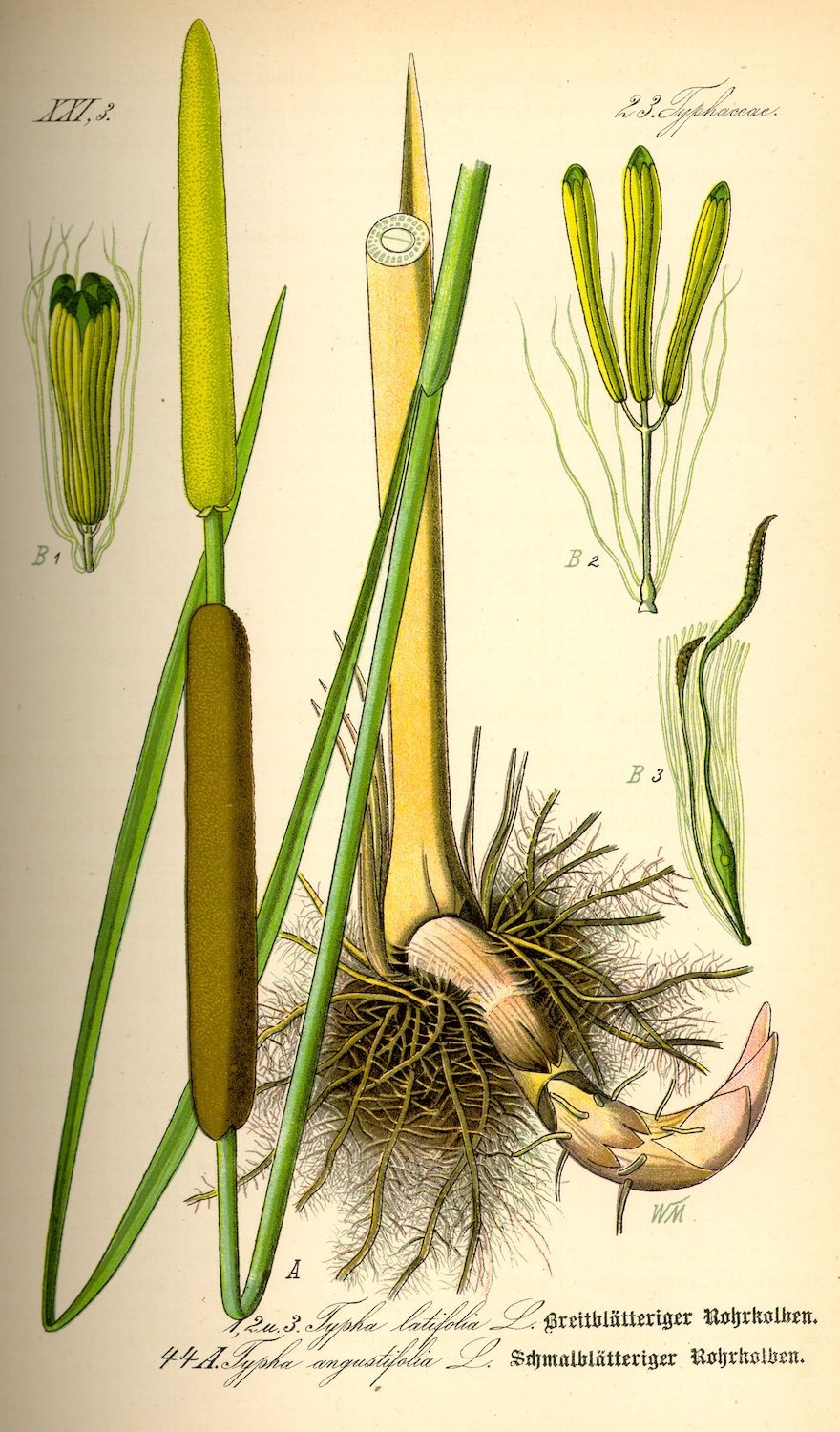Bulrush, the most ancient wetland food
There are some plants that are so ingrained in our visual vocabulary that they have become symbols. This is the case for bulrush. If you think of a pond or marshlands, you visualise bulrushes with their tall stalks and cigar-shaped brown flowering spikes.
Humans have been eating and using bulrush forever, all over the world. In Italy, we still use it for weaving chair seats and as an external protective jacket for glass bottles of wine – the typical Chianti look. Bulrush is found across Australia, from the tropics to the desert, and has traditionally been a staple in the diet of Aboriginal and Torres Strait Islander peoples. In my region, Wiradjuri Country, bulrush is known as cumbungi.
Distribution
There are three types of bulrush in Australia: the native narrow-leaved cumbungi (Typha domingensis), widespread throughout the continent; the native broad-leaved cumbungi (Typha orientalis), mostly coastal; and the exotic bulrush (Typha latifolia), less widespread, mostly confined to south-eastern Victoria and Tasmania.
Identification
Bulrush is a perennial water plant with a yearly cycle. Wherever it grows, it forms an extensive network of underground (and underwater) rhizomes. The plant produces new shoots in springtime that can grow to a height of 2 metres.
Leaves and stalks
The leaves are bluish-green and narrow, extending upwards from the rhizome nodes and growing up to 1 metre in length and 50–80 millimetres wide. The long, straight stems are round in cross-section and can grow to 3 metres tall.
Flowers and seeds
The flowers are the main feature of this self-pollinating plant and the most recognisable part. At the end of each flower spike, there are two sets of swollen ‘cobs’, packed with tiny flowers – the male cob at the top and the female below it. The male cob will disappear after pollinating the female flowers, while the female cob, which is green at first, will develop seeds and turn brown once it has been fertilised. These brown seeds soon form a kind of fluff, which is picked up by the wind or drops to the water below; the seeds then germinate in mud or in water, forming rhizomes.
Root
The roots form an underground network of rhizomes and spread to establish themselves by colonising the surrounding area. The rhizomes form nodes, and from these new shoots will rise up as reeds. When you harvest the new shoots they will be quite crunchy, then later in life they become very fibrous and stringy.
Mature flowering stalks of bulrush
Harvesting young shoots of bulrush in a pond
Young edible shoot of bulrush
How to eat bulrush
The most commonly eaten parts of the plant are the young shoots and the flowering cobs when green. They can be roasted, eaten raw or added to soups.
The young shoots taste similar to sweet corn, and a very nutritious flour can be extracted from the stalks and roots by drying them and bashing the starch out of the fibrous parts.
Another interesting product sourced from this plant is the pollen, which can be collected from the male flowering spikes and used in baking as a protein-rich additive for flour. It has a mild, sweet taste, starchy but very pleasant when fresh.
I like to eat the stalks of young plants, straight from the pond, with my feet wet. I pull up the stalk, peel it back to the inner, crunchy, juicy parts, and enjoy it there and then. It really tastes like sweet corn.
Below I share another recipe developed with chef Joey Astorga for an event. I have made this several times since, and the trick to it is freshness: you really need to find fresh shoots and use them within a day. The result is a crisp, surprising and filling salad.
PLEASE NOTE: Bulrushes, like other aquatic and swamp plants, can sometimes grow in polluted waters. They have been known to accumulate heavy metals and toxins, so only harvest where you know the water source is reasonably clean.
Cumbungi and sow-thistle slaw
Serves 6
Ingredients
1 garlic clove, crushed
½ small red onion, finely sliced
1 teaspoon Dijon mustard
1 cup whole egg mayonnaise
1 tablespoon apple cider vinegar
1 bunch dill, chopped
1 bunch parsley leaves, chopped
¼ purple cabbage, shredded
15–20 young cumbungi or bulrush shoots, finely sliced (you will need to peel off the outer layers of the cumbungi stalks to get down to the young shoots inside, which are the sweet, crunchy part you want for this recipe)
4 cups sow-thistle leaves, finely chopped
Salt and pepper, to taste
Feel free to add grated carrot or finely sliced red capsicum for more colour
Method
1. Mix together the garlic, onion, mustard, mayonnaise, vinegar and herbs to make a dressing.
2. Toss the cabbage, bulrush shoots and sow thistle together in a large bowl.
3. Mix the dressing through the salad and serve.
4. Share your harvesting tale to impress your dinner guests.
Bulrush as ancient food
Humans have been eating the starch-reach roots and seeds of bulrushes for thousands of years. Archeological evidence strongly suggests that Typha species were ‘farmed’, collected, prepared, cooked and eaten as far back as 30,000 years ago in Italy, Russia and the Czeck Republic and 10,000 years ago in China. Bulrushes are also recorded as an important food source for Indigenous populations of Africa, North America, South America, Australia and New Zealand. The nutrition, ease of harvest and mass availability of the plant saw it as a critical food source all over the world.
Is it time to rediscover this plant?
Reference
Bulrush distribution in Australia: bie.ala.org.au
Wikipedia on bulrush: en.wikipedia.org
30,000-year-old evidence of plant food processing: pmc.ncbi.nlm.nih.gov
Bulrush overview: tropical.theferns.info
Dean Green on bulrush: eattheweeds.com
Edible Wild Food on Bulrush: ediblewildfood.com
Anthropology from the shed on bulrushes uses in Australia: anthropologyfromtheshed.com
The consumption of bulrushes in South America: researchgate.net
The consumption of bulrushes in prehistoric China: researchgate.net
The consumption of bulrushes in New Zealand: journals.plos.org
Traditional uses of bulrushes amongst First Nations in North America: naeb.brit.org










